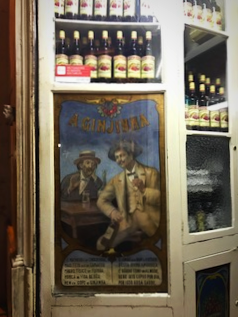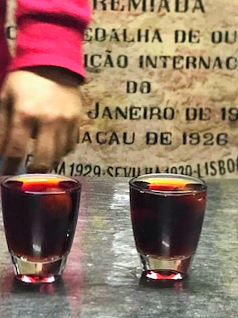Whenever French Husband and I travel it is usually a last minute decision (since we both work from home and the internet is our office desk freedom to do so is easier), with next to zero preparation, and our only desire is to "let it find us" instead of having to see it all. We travel with small expectations which living in Europe affords us that luxury as traveling two hours by plane can take us to a whole new world.
Ryan Air is another advantage.
The day we arrived French Husband and I started out walking, aimlessly. Going where ever I eye caught something or as Yann says, "Corey's Feeling".
We found out within five minutes that Lisbon is hilly with the most intricately beautiful cobblestone sidewalks. As I had fallen face first a few days earlier I held on Yann's arm most of the time out of love and fear. Though love would have been enough.
Lisbon is easy to get around on foot or by trams, buses, tuk-tuks, metro lines, taxis… without an ounce of intimidation.
Though it is hilly, in the historical center stairs often lining the streets.
Some of the places I found charming and a must see:
Follow this link to see a few…
LUVARIA ULISSES
A 1920's charming glove shop
Rua do Carmo, 87A (Chiado)
Bertrand's
1732 the oldest bookshop in the world, and wall to wall books,
Rua Garrett, 73-75 (Chiado)
TOUS (OURIVESARIA ALIANÇA)
For over 100 years this was the jewelry store, though, in 2012 the owners changed, thankfully the interior has not changed. It is one of Lisbon's most beautiful shop, Louis XV-style.
Rua Garrett, 50 (Chiado)
A VIDA PORTUGUESA
An old fashion flair shop with long-forgotten products made in Portugal, in a former storage space filled with wooden cabinets, and filled with a large variety of Portugal's famous soaps. ( soaps by Claus Porto in art deco boxes (clausporto.com)
Rua Anchieta, 11 (Chiado)
EMBAIXADA
What started as a palatial residence in the 1800s is now Lisbon's most interesting shopping destination Praça do Príncipe
Real, 26 (Príncipe Real)
Loja du SE
My mother inherited a woolen blanket that my grandfather brought with him from the Azores, because of that blanket I wanted to find one of my own…
Woolen goods, blankets, scarves, coats, hats, toys… The colors and patterns were given an updated version of the old styles, yet each item is traditionally made. They have an online shop as well.
Rua Augusto Rosa 22-24
Perfumaria Alceste
Is filled with dusty bottles of homemade cologne and fragrance. An old-fashioned style woman who did not smile refused to let me take a photo. The shop was out of a movie set!
Rua da Conceição 85
I could go on and on, but I will save some for tomorrow.
"The Elevador de Santa Justa is a 19th-century lift that transports passengers up the steep hill from the Baixa district to the Largo do Carmo and the ruins of the Carmo church. The lift dates from an era when wrought-iron was both a construction material and art form, and the structure is adorned with glorious neo-gothic arches and geometric patterns, while inside two sumptuous polished wood carriages whisk passengers up in style."
This tiny bar serves only one drink, and rightly so.
I noticed people standing outside sipping from tiny glasses.
The Ginjinha bar is located on a charming street where I felt I had stepped back in time. A few doors down there was a seed shop, wooden shelves wall to wall, floor to ceiling full of seed packets.

Anyway, since French Husband could not get why I found that seed shop "too cute" and why it was so unusual we carried on. But when I saw the Ginjinha bar, well nothing could stop me from giving it a try.
Ginjiha Bar has one man pouring and washing the glasses. He fills them to the brim and never overspilled, I love that he had a cherry red sweater.
xxx
"Ginja is a sweet cherry liqueur that originated in Lisbon, and the small A Ginjinha bar is the traditional home of the drink. The A Ginjinha bar, also known as Ginjinha Espinheira bar, provides visitors with the opportunity to sample this wonderfully strong and sweet alcoholic drink. Ginja is based upon a fortified wine that has been infused with Ginja cherries and combined with vast amounts of sugar.
The Ginja drink is served straight, with the choice of either an alcohol-laden cherry or not. The Portuguese are incredibly fond of this drink, as it was a "grand-parent" wonder cure for all manner of illnesses, and this love of the drink has been passed on to younger generations. Ginja is the shortened name of Ginjinha.
The Ginjinha Espinheira bar was founded in 1840.
The shop "Ginjinha do Largo de Sao Domingo's" was owned by a Galician named Espinheira and was the first bar in Lisbon to sell the beverage. Advised by a friar from the Igreja de Santo Antonio, Espinheria experimented by letting cherries ferment in brandy and then adding sugar, water and cinnamon.
There are two variants of the drink of Ginja either with or without cherries. As the cherries have been soaked in the liquor, they give an additional kick to the drink. The special Ginjinha cherries are Morello Cherries or more commonly known as Sour Cherries. The miniature Ginjinha Espinheira bar remains busy from the moment it opens in the morning until the last person staggers home, attracting both tourists and Portuguese alike.
The Ginjinha bar lies to the east of the Teatro Nacional Doña Maria II in the Praça Dom Pedro IV square, which is more commonly known as Rossio. A shot of the sweet drink costs €1.20, and served in a small glass. "


Leave a Reply